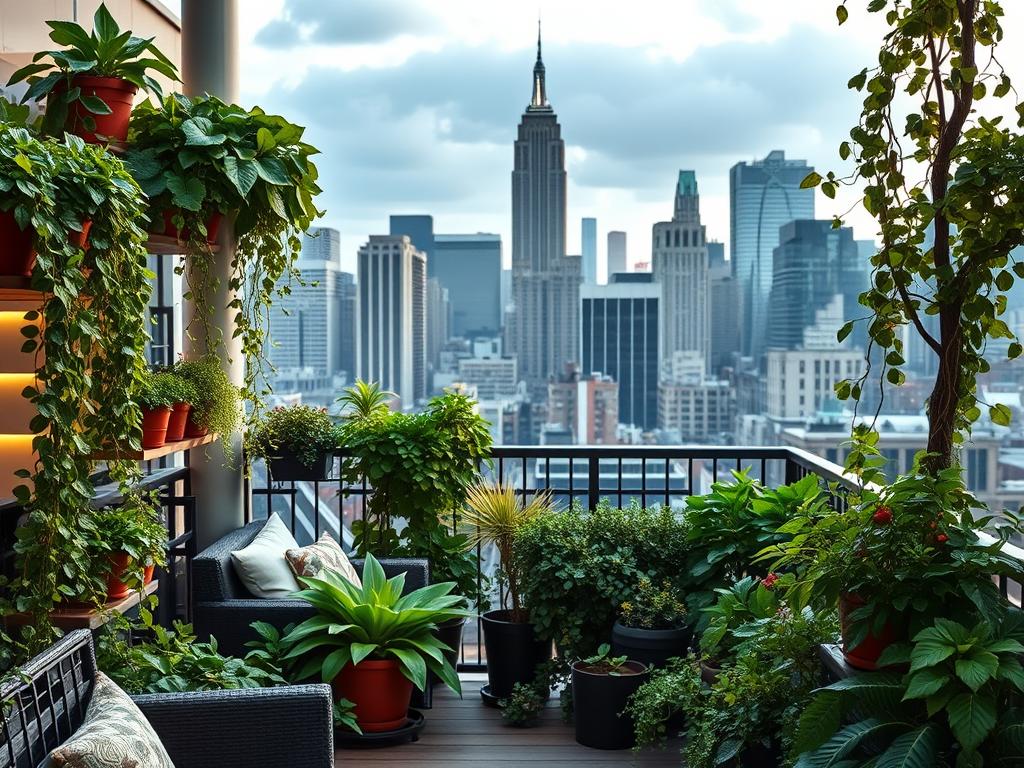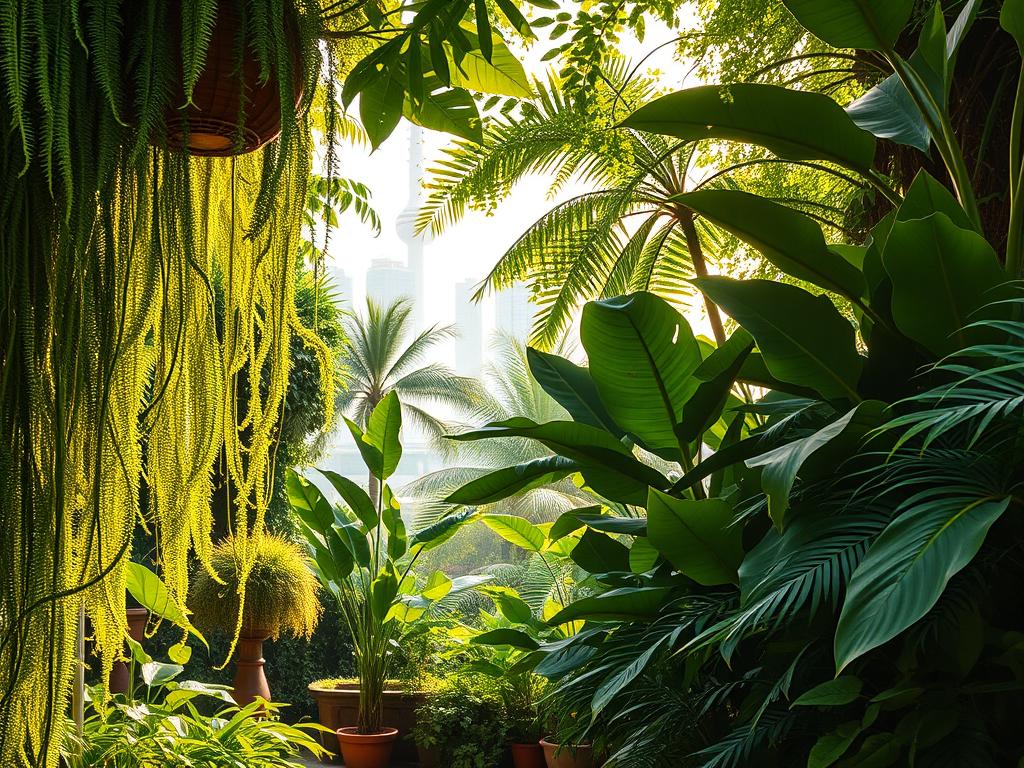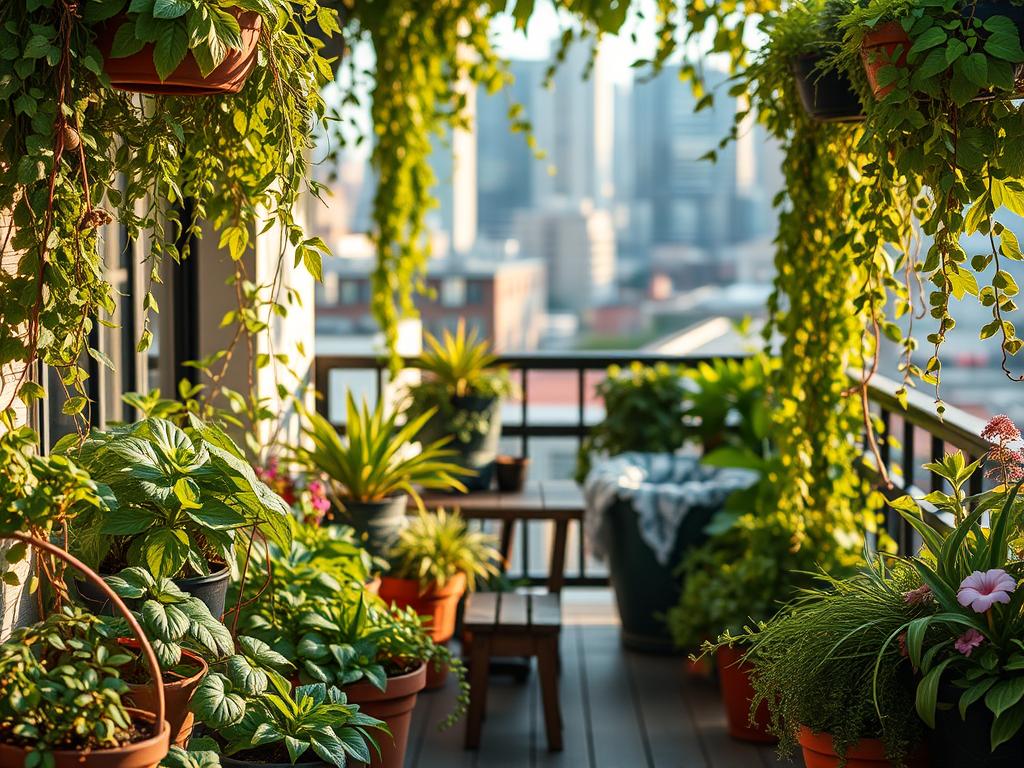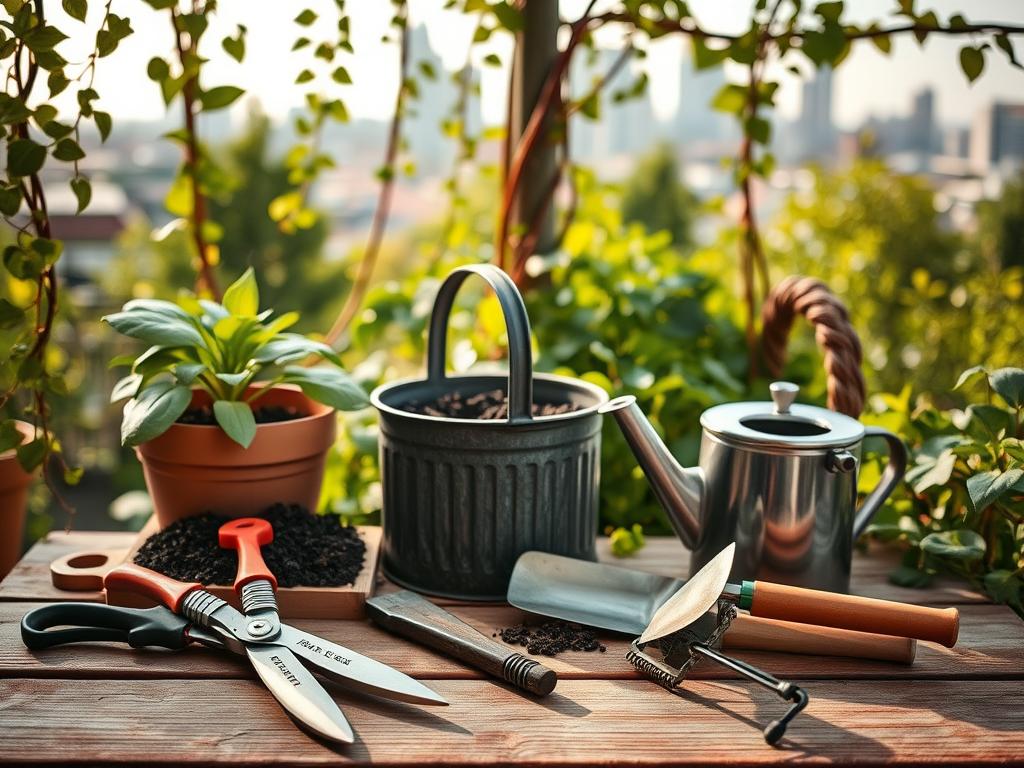
Transform Your Balcony into a Green Sanctuary: Urban Jungle Tips
Can a small balcony in the heart of the city become a tranquil oasis? For those living in metropolitan areas, the idea of having a lush, green space amidst the concrete jungle may seem like a distant dream. However, with a little creativity and some expert tips, it’s entirely possible to transform your balcony into a serene escape.
Creating an Urban Jungle in your city living space not only enhances the aesthetic appeal of your home but also provides a much-needed respite from the stresses of city life. By incorporating the right plants, decor, and design elements, you can turn your balcony into a vibrant and peaceful retreat.
As we explore the possibilities of turning your urban environment into a green sanctuary, we’ll delve into practical tips and inspiring ideas to help you get started on this exciting journey.
Understanding the Concept of an Urban Jungle
As urbanization continues to shape our concrete jungle, the idea of bringing nature indoors and outdoors has gained significant traction. The urban jungle concept is not just about gardening; it’s a lifestyle choice that integrates nature into the metropolitan lifestyle, enhancing the aesthetic and environmental quality of urban spaces.
Defining Urban Jungle and Its Appeal
The term “urban jungle” refers to the practice of creating lush, vibrant environments within urban settings, typically through indoor and balcony gardening. This concept appeals to city dwellers seeking to reconnect with nature and mitigate the stresses of urban living. By transforming balconies and indoor spaces into green sanctuaries, individuals can create oases that promote well-being and tranquility.
The appeal of the urban jungle lies in its ability to bring the serenity of nature into the midst of bustling city life. It allows residents to cultivate a sense of community and connection to the natural world, even in densely populated areas.
Benefits of Indoor and Balcony Gardening
Indoor and balcony gardening offer numerous benefits, from improving air quality to enhancing mental health. These practices are integral to urban landscaping, as they contribute to a more sustainable and livable urban environment.
| Benefits | Indoor Gardening | Balcony Gardening |
|---|---|---|
| Air Quality Improvement | Removes pollutants and toxins | Increases oxygen levels |
| Mental Health | Reduces stress and anxiety | Promotes relaxation and calmness |
| Aesthetic Appeal | Enhances interior decor | Creates outdoor living spaces |
By embracing indoor and balcony gardening, individuals can not only beautify their living spaces but also contribute to a healthier urban environment. As the urban jungle concept continues to grow in popularity, it’s clear that this trend is more than just a passing fad – it’s a meaningful shift towards a more sustainable and nature-connected lifestyle.
Choosing the Right Plants for Your Space
Selecting the right plants is crucial for transforming your balcony into a thriving urban jungle. The right plants not only enhance the aesthetic appeal of your outdoor space but also contribute to a healthier environment.

Ideal Plants for Beginners
For those new to gardening, it’s essential to start with plants that are easy to care for and can thrive in a variety of conditions. Some ideal plants for beginners include Snake Plants, ZZ Plant, and Herbs like basil and mint. These plants are hardy, require minimal maintenance, and can tolerate some neglect.
Succulents vs. Tropical Plants
When deciding on plants for your balcony, two popular options are succulents and tropical plants. Succulents are perfect for balconies with plenty of sunlight and require less watering, making them ideal for busy individuals. On the other hand, tropical plants can add a lush, vibrant feel to your space but often require more care and protection from extreme weather conditions.
- Succulents: Low watering needs, full sun tolerance
- Tropical Plants: Higher watering needs, often require shade
Seasonal Considerations
It’s also important to consider the seasonal changes when selecting plants for your balcony. Some plants thrive in the spring and summer, while others do better in the cooler temperatures of fall and winter. Understanding these seasonal preferences can help you choose plants that will flourish throughout the year, creating a dynamic and ever-changing cityscape on your balcony.
| Season | Plant Type | Care Tips |
|---|---|---|
| Spring/Summer | Tropical Plants, Herbs | More frequent watering, fertilization |
| Fall/Winter | Succulents, Hardy Plants | Less watering, protection from frost |
By considering these factors and choosing the right plants for your balcony, you can enjoy an urban exploration of gardening and create a beautiful, thriving outdoor space.
Maximizing Space on a Small Balcony
City dwellers often face the challenge of maximizing space on their balconies, but with the right techniques, even the smallest areas can become verdant retreats. In urban environments, where space is at a premium, creativity is key to transforming your balcony into a lush oasis.
Vertical Gardening Solutions
One of the most effective ways to maximize space is through vertical gardening. By using wall-mounted planters or trellises, you can grow a variety of plants upwards, making the most of your balcony’s vertical space. This not only adds more room for plants but also creates a visually appealing green wall.
- Trellises for climbing plants like ivy or clematis
- Wall-mounted planters for herbs or succulents
- Vertical gardening kits that include everything needed to get started
Creative Container Ideas
The choice of containers can greatly impact the overall look and feel of your balcony. Creative container ideas can help maximize space while adding aesthetic value. Consider using hanging baskets, stackable planters, or even repurposed items like old boots or wooden crates.
| Container Type | Ideal Plants | Space Efficiency |
|---|---|---|
| Hanging Baskets | Trailing plants like petunias or ferns | High |
| Stackable Planters | Herbs, succulents, or small vegetables | Very High |
| Repurposed Containers | Varied, depending on the container | Variable |
Utilizing Railings and Walls
Making the most of your balcony’s railings and walls is crucial for maximizing space. Consider attaching planters or hooks to hang plants, or using a railing planter that fits snugly around the balcony railing. This not only adds more planting space but also helps to create a lush, enclosed feel.

By implementing these strategies, you can turn even the smallest balcony into a thriving urban jungle, perfect for relaxing and enjoying the outdoors in the midst of city living.
Essential Gardening Tools for Balcony Spaces
To transform your balcony into a lush oasis, you’ll need some essential gardening tools. Gardening in urban settings, often referred to as creating an urban jungle, requires careful selection of tools to maintain a thriving green space, even in the midst of a concrete jungle.
Must-Have Tools for Plant Care
For effective plant care, several tools are indispensable. These include a watering can or a watering globe to ensure plants receive the right amount of water, pruning shears for trimming and shaping plants, and a trowel or small shovel for planting and mixing soil. Embracing the metropolitan lifestyle with a balcony garden means having these tools at your disposal.
- A watering can or watering globe
- Pruning shears
- A trowel or small shovel
Organic Fertilizers and Soil Types
Choosing the right fertilizer and soil can significantly impact the health of your plants. Organic fertilizers, such as compost or manure, provide nutrients without the harmful chemicals found in synthetic fertilizers. For those looking to create a sustainable urban jungle, organic options are preferable.
| Soil Type | Description | Best For |
|---|---|---|
| Peat-based | Retains moisture well | Seed starting, plants that prefer moist conditions |
| Compost-based | Rich in nutrients | Vegetables, flowering plants |
| Soil-less mix | Lightweight, good drainage | Containers, plants that prefer drier conditions |

Designing a Relaxing Green Space
Transforming your balcony into a relaxing green space can be a therapeutic escape from city living. A well-designed balcony not only enhances the aesthetic appeal of your home but also provides a serene atmosphere where you can unwind.
To achieve this, it’s essential to focus on several key elements. First, consider the comfort and functionality of your balcony. This involves creating comfortable seating arrangements that invite relaxation.
Creating Comfortable Seating Arrangements
A good seating arrangement is crucial for a relaxing balcony. Choose furniture that is not only comfortable but also weather-resistant. Consider outdoor sofas or hammocks that can provide the perfect spot to enjoy your green sanctuary. Adding throw pillows and blankets can enhance the coziness of the space.
When selecting seating, keep in mind the layout and how it will flow with the rest of your balcony design. You may also want to consider multi-functional pieces that can serve more than one purpose, such as storage ottomans.
Incorporating Decorative Elements
Decorative elements can significantly enhance the ambiance of your balcony. Incorporate elements that reflect your personal style, such as art pieces, lanterns, or wind chimes. These not only add visual interest but can also create a soothing atmosphere.
When choosing decorative elements, consider the overall aesthetic you want to achieve. For a cityscape view, you might opt for modern, sleek designs, while a more natural, earthy tone might suit a balcony surrounded by greenery.

Balancing Plant Density
One of the key aspects of an urban jungle balcony is the density of plants. While it’s tempting to fill every available space with greenery, it’s crucial to strike a balance. Too many plants can make the space feel cluttered and overwhelming.
To achieve a balanced look, mix larger plants with smaller ones, and vary the textures and colors. This not only creates visual interest but also ensures that the space remains relaxing and easy to navigate. Consider the mature size of plants when placing them to avoid overcrowding as they grow.
By carefully designing your balcony with these elements in mind, you can create a truly relaxing green space that serves as a perfect retreat from the hustle and bustle of urban exploration and city life.
Watering and Maintenance Tips
Creating an Urban Jungle on your balcony involves understanding the intricacies of watering and maintenance to ensure your plants flourish.
Proper watering is crucial for the health and survival of your balcony garden. The frequency of watering depends on several factors, including the type of plants, the size of the containers, and the prevailing weather conditions.
Establishing a Watering Routine
To establish an effective watering routine, it’s essential to understand the specific needs of your plants. Succulents and cacti, for instance, require less frequent watering compared to tropical plants. A general rule of thumb is to water plants when the top inch of soil feels dry to the touch.
Here’s a simple guide to help you get started:
- Check the soil moisture by inserting a finger into the soil.
- Water plants in the morning to minimize evaporation.
- Avoid getting water on the leaves to prevent fungal diseases.
Signs of Overwatering and Underwatering
Being able to identify signs of overwatering and underwatering is crucial for maintaining a healthy balcony garden. Overwatering can lead to root rot, while underwatering can cause stress to the plants.
| Condition | Signs | Action |
|---|---|---|
| Overwatering | Yellowing leaves, soft stems, waterlogged soil | Reduce watering frequency, improve drainage |
| Underwatering | Dry soil, wilted leaves, slow growth | Increase watering frequency, ensure adequate soil moisture |
By understanding and implementing these watering and maintenance tips, you can ensure your Urban Jungle thrives, providing a serene oasis in the midst of the urban environment.
Enhancing Biodiversity on Your Balcony
Even in a cityscape dominated by steel and concrete, you can cultivate a lush balcony that teems with life. Enhancing biodiversity on your balcony is not only about beautifying your outdoor space; it’s also about creating a haven for local wildlife in the midst of a metropolitan lifestyle.
By adopting a few simple strategies, you can transform your balcony into a thriving ecosystem that supports a variety of plant and animal life, even in the heart of a concrete jungle.
Attracting Pollinators and Beneficial Insects
One of the key ways to enhance biodiversity on your balcony is by attracting pollinators and beneficial insects. These creatures are essential for the health of your plants and the overall ecosystem. To attract them, consider planting a variety of flowers that are rich in nectar and pollen, such as sunflowers, zinnias, and lavender.
- Choose plants with different blooming periods to provide a constant source of food for pollinators throughout the growing season.
- Incorporate native plants into your balcony garden, as they are more likely to attract local pollinators and beneficial insects.
- Avoid using pesticides, which can harm or kill beneficial insects. Instead, adopt natural methods of pest control.
Companion Planting Strategies
Companion planting is another effective strategy for enhancing biodiversity on your balcony. This involves growing different plants together to improve their growth, health, and productivity. For example, planting marigolds with tomatoes can help deter nematodes, while basil can improve the flavor and aroma of nearby vegetables.
Some other beneficial companion planting combinations include:
- Planting nasturtiums with cabbage to repel aphids, whiteflies, and other pests.
- Growing beans with corn and squash (the “Three Sisters”) to create a symbiotic relationship that enhances soil fertility and structure.
- Using herbs like mint and lemongrass to repel pests that target vegetables and flowers.
By implementing these strategies, you can create a diverse and resilient balcony ecosystem that thrives in the urban environment.
Overcoming Urban Gardening Challenges
The urban environment poses unique challenges to gardening, but with the right strategies, these can be overcome. Urban gardening enthusiasts often face issues such as limited sunlight and pest infestations, which can hinder the growth and health of their plants.
Dealing with Limited Sunlight
Not all balconies receive ample sunlight, which is crucial for plant growth. To address this, gardeners can opt for plants that thrive in low-light conditions, such as Chinese Evergreen or Pothos. Additionally, using reflective surfaces or mirrors can help in redirecting available sunlight onto the plants.
- Choose shade-tolerant plants.
- Utilize mirrors or reflective surfaces to maximize sunlight.
- Consider using grow lights as a supplement.
Managing Pests Naturally
Pests can be a significant problem in urban gardens. Instead of resorting to chemical pesticides, gardeners can adopt natural methods to manage pests. Companion planting is an effective technique where certain plants are grown together to deter pests. For example, basil repels aphids, and marigold repels nematodes.
Other natural pest control methods include:
- Using neem oil.
- Spraying soapy water.
- Introducing beneficial insects like ladybugs.
Seasonal Planting and Care Routines
To keep your urban oasis thriving, it’s crucial to understand the seasonal planting and care routines. As the seasons change, so do the needs of your plants, requiring adjustments in your gardening strategy to maintain a lush and vibrant balcony garden.
In the context of city living and urban landscaping, adapting to these seasonal changes is particularly important. The metropolitan lifestyle often means dealing with unique challenges such as limited space and varying sunlight, making it essential to be proactive about seasonal gardening.
Preparing for Winter Gardening
Winter can be a challenging time for balcony gardens, especially in colder climates. To prepare, consider the following steps:
- Choose plants that are resilient to cold temperatures, such as kale, spinach, and winter-flowering cyclamen.
- Protect your plants from harsh winds and frost by using covers or bringing them under cover if possible.
- Adjust your watering schedule, as plants require less moisture during the colder months.
Spring Planting Strategies
Spring is a time of renewal and growth, making it an ideal period to refresh your balcony garden. Here are some strategies to consider:
- Start by cleaning up your garden, removing any dead plants or debris accumulated over winter.
- Select a mix of annuals and perennials that thrive in the spring season, such as tulips, daffodils, and pansies.
- Consider repotting plants that have outgrown their containers and refresh the soil with organic fertilizers.
By embracing these seasonal planting and care routines, you can ensure your urban jungle remains a vibrant and welcoming space throughout the year, enhancing your metropolitan lifestyle and contributing to a more sustainable city living environment.
Indoor Link: Connecting Your Balcony with Living Space
In the heart of the concrete jungle, connecting your balcony with your living space can be a game-changer. This integration not only enhances the aesthetic appeal of your home but also creates a more spacious and airy feel.
One effective way to achieve this connection is through open floor plans and careful consideration of visual flow. Open floor plans involve removing or minimizing barriers between the indoor and outdoor spaces, creating a sense of continuity.
Open Floor Plans and Visual Flow
To implement an open floor plan, consider sliding glass doors or large windows that lead out to your balcony. This design not only allows for an unobstructed view of your outdoor space but also permits natural light to flood your indoor areas, creating a brighter and more welcoming atmosphere.
Visual flow is equally important, as it guides the eye smoothly from indoors to outdoors. This can be achieved by using similar flooring materials or colors in both spaces, creating a sense of cohesion. Additionally, placing plants or decorative elements that complement both areas can enhance the visual link between your balcony and living space.
Bringing the Outdoors In
Bringing the outdoors in involves incorporating elements of nature into your indoor space. This can be done through the use of natural materials, such as wood or stone, in your decor. Moreover, adding plants to your indoor space not only purifies the air but also creates a visual connection to your balcony garden.
Another strategy is to use outdoor-inspired decor indoors. For example, using outdoor furniture or decorative items inside can blur the lines between the two spaces. Furthermore, installing a living wall or a green wall can be a dramatic way to bring the outdoors in, adding a touch of the cityscape to your interior.
By implementing these strategies, you can create a harmonious and flowing living space that seamlessly integrates your balcony with your indoor areas, perfect for urban exploration and relaxation.
The Environmental Impact of Urban Jungle Gardening
Creating an urban jungle on your balcony is not just about beautifying your personal space; it also contributes to a healthier urban environment. In metropolitan areas, where green spaces are often limited, balcony gardens play a significant role in mitigating the effects of urbanization.
Mitigating Urban Heat
Urban jungle gardening helps reduce the urban heat island effect, a phenomenon where built-up areas absorb and retain heat, making cities warmer than surrounding rural areas. By incorporating plants on balconies, residents can lower the ambient temperature through evapotranspiration, the process by which plants release water vapor into the air.
Improving Air Quality
Urban gardens also contribute to improved air quality by absorbing pollutants and producing oxygen. In densely populated urban environments, this can lead to significant health benefits for residents. By adopting urban jungle gardening, individuals can enhance not only their own living space but also contribute to a cleaner, healthier metropolitan lifestyle.
Leave a Reply